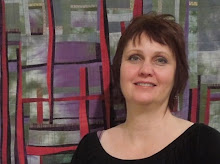 My studio is a little less than 8 feet wide, set up so I can move between sewing, cutting, pressing and designing stations by simply rolling and rotating in my chair. I have felt-covered Styrofoam boards nailed to the walls, and a couple of free-standing design boards. Fabric pieces easily cling to the felt surface and I can stick a pin through the Styrofoam if needed. These design walls are usually covered with works-in-progress, and sections of strip pieced fabrics from which I construct my art quilts.
My studio is a little less than 8 feet wide, set up so I can move between sewing, cutting, pressing and designing stations by simply rolling and rotating in my chair. I have felt-covered Styrofoam boards nailed to the walls, and a couple of free-standing design boards. Fabric pieces easily cling to the felt surface and I can stick a pin through the Styrofoam if needed. These design walls are usually covered with works-in-progress, and sections of strip pieced fabrics from which I construct my art quilts.I sort and store my fabric in clear plastic boxes - the size made to fit under a bed. Every piece of fabric, whatever the length or width, is wrapped around a 6" acrylic ruler - and then I slip the ruler out so I have a flat roll of fabric. I stack the fabric on end in the boxes, so I can see the skinny edge of every piece in the box. Each box contains a color collection of fabrics - mixing prints, solid and hand-dyed fabrics, in pieces ranging from a few inches wide to a yard or two.
I cut strips of fabric using a rotary cutter, but no ruler, As I cut, I toss the strips in piles like fabric fettuccini. I will cut a variety of widths, in a range of values, hues and visual textures. The greater the number of different fabrics, the better they seem to work together. I organize these loose strips in large plastic baggies - hanging from a clothesline that stretches across the room above my head.





